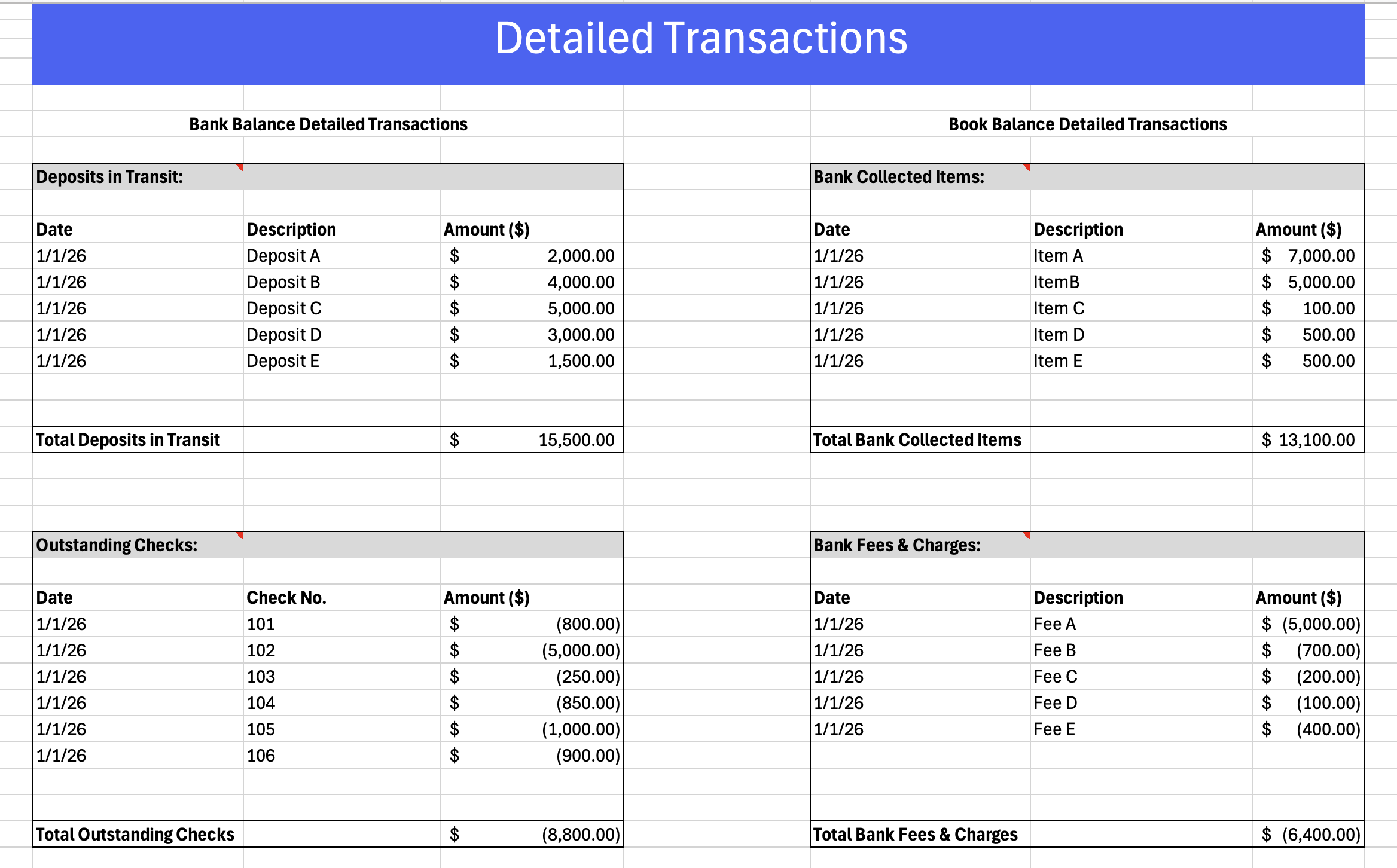Templates | Bank Reconciliation
Bank Reconciliation Template
Bank Reconciliation Template
Looking for a free bank reconciliation template?
Looking for a free bank reconciliation template?
Download our free excel template today.

Download our bank reconciliation template to streamline your accounting!
Download now to keep your finances in check, catch errors early, and avoid costly mistakes! Our Simple Excel bank reconciliation template ensures your financial records match your bank’s, helping you stay on top of cash flow and spot any discrepancies quickly.
Bank reconciliation might sound like a formal accounting chore, and unfortunately, it sort of is. At the end of the day, it’s just about making sure your records match what the bank says happened. Whether you’re running a business or managing your organization’s finances, reconciling your accounts regularly helps you catch errors, spot fraud, and keep your books accurate.
If you’ve ever looked at your bank statement and thought, “Wait, that’s not what I have in my spreadsheet,” then you already get why this matters.
What is a bank reconciliation?
Bank reconciliation is the process of comparing a company’s internal financial records with those of its bank account to ensure they match. This helps identify discrepancies such as missing payments, errors in the bank’s records, or mistakes in the company’s accounting. Essentially, it’s a way to confirm that the balance on your company’s books is in harmony with what the bank says you have.
Imagine this: You’re about to write a check for a new project, but when you look at your account balance, it seems off. You know you’ve had several expenses recently, but some payments haven’t appeared in your records yet. By reconciling your bank account, you can figure out exactly where those differences come from, ensuring that your balance is accurate before making any decisions.
Why is this important? Accurate bank reconciliation helps prevent fraud, spot errors, and avoid any surprises in your finances. It gives business owners a clearer picture of their financial health, which is crucial for making informed decisions.

How to do a bank reconciliation?
It’s not as complicated as people think. It’s mostly a matter of comparing two sources of truth: your internal records (like your accounting software or check register) and the bank statement for the same time period. Here’s a step-by-step walkthrough:
Step 1: Gather your documents
You’ll need:
- Your internal records (this could be from QuickBooks, Excel, or wherever you track transactions)
- The bank statement for the period you’re reconciling (monthly is most common)
It helps if you’ve already entered all transactions up to the statement’s end date. If not, go ahead and do that first.
Step 2: Check off matching transactions
Start by going down the bank statement and checking each transaction against your records. For every deposit or withdrawal, look for a match in your books. If it’s there and the amount is correct, check it off.
This step is where the detailed transaction list becomes really important. Your bank statement will usually show a breakdown of every payment, deposit, and fee that cleared during the period. On your side, your accounting records should reflect the same activity. Reconciling these line by line helps you catch timing issues or missed entries early on.
Here’s an example of what those detailed transactions typically look like in a bank reconciliation

Some people like to do this manually with a printed copy and a highlighter. Others do it right inside accounting software, which often has built-in reconciliation tools.
Step 3: Note any discrepancies
There will probably be a few. Common ones include:
- Checks you wrote that haven’t cleared yet
- Deposits in transit (you recorded it, but the bank hasn’t yet)
- Bank fees, interest, or automatic charges you didn’t enter
Make a list of anything that doesn’t match. Sometimes it’s just a timing issue. Other times, it’s something you missed—or a bank error that needs following up.
Step 4: Adjust your records
Once you’ve spotted the differences, go ahead and make any needed corrections in your books:
- Add missing transactions (like a bank fee you forgot to log)
- Fix data entry mistakes (maybe you flipped two numbers in a deposit)
- Flag anything suspicious or unexpected for review
You don’t want to force the numbers to match—you want to understand why they don’t and fix the underlying issue.
Step 5: Compare ending balances
Now look at your adjusted book balance and compare it to the bank’s ending balance. After accounting for outstanding checks or deposits in transit, the numbers should match.
If they don’t, double-check your math and walk through the reconciliation again. Even a small typo can throw it off.
Bank reconciliation example
Let’s say your internal records show an ending balance of $5,200 for April. But your bank statement shows $4,850.
You scan the transactions and find:
- A check for $500 that hasn’t cleared yet
- A $150 automatic payment for software that you didn’t record
When you adjust your records to include the $150 charge, your balance drops to $5,050. And once you account for the outstanding $500 check, your adjusted book balance ($5,050 – $500 = $4,550) still doesn’t match the bank’s $4,850.
Eventually, you notice a deposit was entered in your records as $1,200 when it was actually $1,500. Fixing that adds $300, bringing everything into alignment.
If you’re someone responsible for keeping your organization’s books straight, this process, while a little tedious, is worth the time. It helps ensure your records are reliable and gives you peace of mind that no money is slipping through the cracks.
Bank reconciliation format
If you’re new to this or just want to make sure you’re following a clear structure, here’s a simple bank reconciliation format you can use. Most formats include:
- Date of reconciliation
- Opening balance (according to your records)
- Additions (e.g., deposits in transit)
- Subtractions (e.g., outstanding checks, bank fees)
- Adjusted book balance
- Bank statement ending balance
- A place to list and explain any discrepancies
You can recreate this in a spreadsheet, or download a bank reconciliation template to get started. The format doesn’t have to be complicated—it just needs to help you clearly compare and match your internal records with the bank’s records.
Reconcile monthly, take your time, and don’t rush the process. The more you do it, the more it becomes second nature. If something doesn’t add up, don’t just ignore it. You’ll learn a lot about your own financial system along the way.